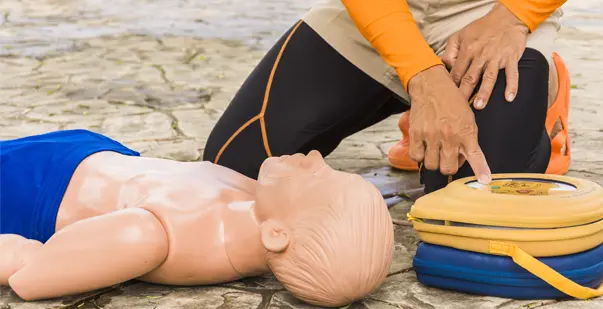
Last Updated On: septiembre 9, 2024
When the heart suddenly stops beating, this is known as sudden cardiac arrest (SCA). Having an AED (Automated External Defibrillator) around and knowing how to use it can make all the difference. You can learn about CPR and AED from the online CPR/AED course by the American CPR Care Association (AHCA). Through our online certification course, you will learn how to use an AED correctly and at the right moment. It increases the chances of survival of a victim or patient of sudden cardiac arrest (SCA).
Fortunately, SCA is not frequent among children. As per the Children’s Hospital of Philadelphia, “SCA is unusual in children, it can affect anyone, even those who are physically active. SCA kills roughly 2,000 children and adolescents in the United States each year. It accounts for approximately 3-5% of all deaths in children aged 5 to 19. It is also to blame for 10-15% of all unexpected baby fatalities.»
First, let’s understand what is an AED:
An SCA victim has the best chance of survival if CPR and defibrillation are started immediately. If a victim in cardiac arrest is not defibrillated within 5 minutes, his or her odds of survival drop by approximately 50%. Each minute without defibrillation reduces the chances of survival by 7%. AEDs are now available in schools, restaurants, supermarkets, parks, private houses, and many other public sites. When seconds count, having an AED on hand is the quickest method to give life-saving care.
According to a study:
With the help of audio instructions and a manual, using an AED becomes easy whenever a child is experiencing cardiac arrest. AEDs include clearly labeled directions for where to lay pads, and a voiceover guides the helper through the procedure. However, all school personnel, including teachers, coaches, and trainers, should receive frequent, formal CPR and AED training. They must ensure they understand the emergency action plan. And learning how to utilize an AED in the event of an emergency must be a part of their profession.
If a child is suffering from SCA, an AED must be used. Young SCA victims are usually athletes during sporting events or practices, hence AEDs should be placed near gymnasiums or athletic fields. Non-athletes can also suffer from SCA, so AEDs should be strategically distributed throughout the campus. Ensure that the pads are appropriate for the victim, especially if the victim is a child under the age of eight.
Do not use an AED under the following conditions:
The American CPR Care Association suggests completing CPR/AED online training for parents and caregivers to learn more about how to use an AED. CPR for children and infants differs from CPR for adults. We strongly recommend that you take a CPR and AED certification course. These lessons will teach you how to conduct adult, child, and infant CPR as well as how to use an AED properly.